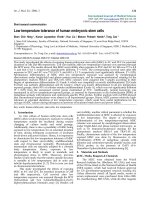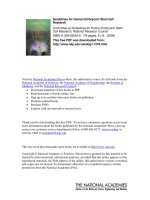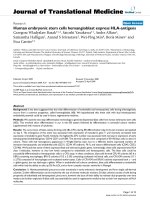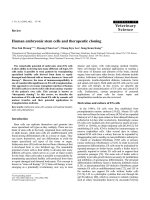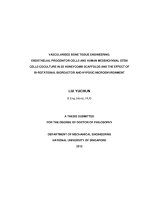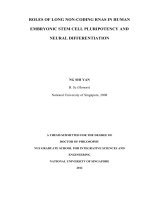Human embryonic stem cell derived neural stem cells derivation, differentiation and MicroRNA regulation
Bạn đang xem bản rút gọn của tài liệu. Xem và tải ngay bản đầy đủ của tài liệu tại đây (2.6 MB, 146 trang )
HUMAN EMBRYONIC STEM CELL-DERIVED NEURAL
STEM CELLS: DERIVATION, DIFFERENTIATION AND
MICRORNA REGULATION
KWANG WEI XIN TIMOTHY
NATIONAL UNIVERSITY OF SINGAPORE
2013
HUMAN EMBRYONIC STEM CELL-DERIVED NEURAL
STEM CELLS: DERIVATION, DIFFERENTIATION AND
MICRORNA REGULATION
KWANG WEI XIN TIMOTHY
(B.Sc. (Hons), NUS)
A THESIS SUBMITTED
FOR THE DEGREE OF DOCTOR OF PHILOSOPHY
NUS GRADUATE SCHOOL FOR INTEGRATIVE
SCIENCES AND ENGINEERING
NATIONAL UNIVERSITY OF SINGAPORE
2013
I hereby
d
its entirety
.
This thesi
s
d
eclare that
.
I have dul
y
s
has also
n
this thesis
y
acknowle
d
n
ot been s
u
_
K
w
Declar
a
is my origi
n
d
ged all th
e
used in th
e
u
bmitted fo
r
_
________
_
w
ang Wei
X
24 Janua
r
a
tion
n
al work an
d
e
sources o
f
e
thesis.
r
any degre
e
_
_______
X
in Timothy
r
y 2013
d
it has be
e
f
informatio
e
in any uni
e
n written b
y
n which ha
v
i
versity pre
v
i
y
me in
v
e been
v
iously.
ii
Acknowledgements
Firstly, I would like to express my gratitude to my supervisor, A/P Wang Shu, for his
support and guidance through my PhD stint. His encouragement, patience and
instruction whilst allowing me to conduct my research independently has made this
journey a valuable experience.
I thank my fellow lab-mates, past and present, for their assistance in my research
work and for making this journey a less arduous and more enjoyable one;
Mohammad Shahbazi, Dang Hoang Lam, Yovita Ida Purwanti, Jiakai Lin, Chrishan
Ramachandra, Yukti Choudhury, Detu Zhu, Kai Ye, Esther Lee, Ghayathri
Balasundaram, Poonam Balani, Seong Loong Lo, Chunxiao Wu, Jieming Zeng, and
Ying Zhao.
I would like to express my sincere thanks to my family, especially my parents for their
unceasing support and provision in all my endeavors. I am also grateful to all my
friends for their prayers and encouragement through this season.
I would like to thank the Institute of Bioengineering and Nanotechnology (IBN) for the
resources and support granted to me to carry out my research work. I also thank
NUS Graduate School of Science and Engineering (NGS) for this opportunity to do a
PhD. Additionally, I would also like to appreciate the NGS administrative staff for ever
being ready to address my queries and to alleviate the administrative challenges that
I may have encountered.
Most of all I would like to thank God for His abundant favor. “He makes me lie down
in green pastures. He leads me beside still waters.” – Psalm 23:2.
iii
Table of Contents
Summary vi
List of Tables viii
List of Figures ix
List of Abbreviations xi
Chapter 1: Introduction 1
1.1 Neural stem cells 1
1.1.1 A brief history of NSCs 1
1.1.2 The “definition” of an NSC 2
1.1.3 NSCs in development and regenerative medicine 4
1.1.4 NSCs in cancer therapy 6
1.1.5 Sources of human NSCs 8
1.1.5.1 Fetal and adult NSCs 8
1.1.5.2 Pluripotent stem cell-derived NSCs 9
1.2 Factors regulating self-renewal and differentiation of NSCs 11
1.2.1 Transcription factors 12
1.2.1.1 PAX6 13
1.2.1.2 SOX2 15
1.2.2 Extracellular factors 19
1.2.3 Epigenetic factors 21
1.3
MicroRNAs 22
1.3.1 Overview 22
1.3.2 Biogenesis 23
1.3.3 Mechanism of action 26
1.3.3.1 Target recognition 26
1.3.3.2 Target gene silencing 27
1.3.4 miRNAs in NSC self-renewal and fate commitment 30
1.4 Aims and objectives 32
Chapter 2: Materials and Methods 35
iv
2.1 Cell culture 35
2.2 Generation of NSCs from hESCs 35
2.3 Generation of GPCs from hESC-derived NSCs 37
2.4 Terminal differentiation of hESC-derived NSCs into glial cells and
neurons 38
2.5 Immunocytochemistry 38
2.6 RNA isolation 39
2.7
Reverse transcriptase-PCR and Quantitative RT-PCR of mRNA 39
2.8 Flow cytometry 41
2.9 Western blot analysis 41
2.10 In vitro migration assay 43
2.11 MicroRNA microarray 43
2.12 MicroRNA target prediction 44
2.13 Quantitative RT-PCR of miRNA 45
2.14 miRNA mimics, miRNA expression vectors and transfection 46
2.15
Luciferase reporter assay 47
2.16
Baculovirus preparation and transduction 49
2.17
Statistical analysis 51
Chapter 3: Derivation of neural progenitors from hESCs 52
3.1 Introduction and aims 52
3.1.1 Deriving NSCs 52
3.1.2 Deriving GPCs 53
3.2 Results 55
3.2.1 NSCs derived from hESCs via neurosphere culture display
neuroectodermal identity 55
3.2.2 NSCs derived from hESCs via neural rosette formation display
neuroectodermal identity 59
v
3.2.3 Downregulation of early neuroectodermal genes and upregulation of
GPC markers during differentiation from NSCs to GPCs 61
3.2.4 In vitro glioma-tropic properties of genetically modified hESC-derived
NSCs and GPCs 67
3.3 Discussion 73
3.3.1 hESC-derived NSCs 73
3.3.2 hESC-derived GPCs 75
3.3.3 Future work 78
Chapter 4: Regulation of neuroectodermal genes by miRNA 80
4.1
Introduction and aims 80
4.2 Results 82
4.2.1 miR-22, -21, -221 and -145 are upregulated in GPCs compared to
NSCs and are predicted to target PAX6 mRNA 82
4.2.2 PAX6 is a prospective target of miR-22 and miR-221 88
4.2.3 miR-145 is predicted to target SOX2 94
4.2.4 SOX2 is downregulated by miR-145 in NSCs 95
4.3 Discussion 105
4.3.1 Future work 108
Chapter 5: Summary and conclusion 110
References 113
Appendices 131
vi
Summary
Over the last two decades there is burgeoning interest in neural stem/progenitor cells
(NSCs) for both developmental research and cell-based therapeutic applications.
Although functional properties of human NSCs, in terms of their tumor-homing, in
vivo regenerative and in vitro differentiation capacities, have been extensively studied,
the molecular mechanisms underlying their self-renewal and differentiation are
incompletely, if not poorly, understood. Human embryonic stem cells (hESCs) offer a
valuable source of NSCs to elucidate these mechanisms. Here, we derived NSCs
from hESCs and further differentiated these hESC-derived NSCs into NG2+ glial
progenitor cells (GPCs). PAX6 and SOX2 are two transcription factors that
characterize NSCs, and function as key determinants of the human neuroectodermal
fate that drive neurogenesis or self-renewal, respectively. Accordingly, we observed
the downregulation of PAX6 and SOX2 expression in hESC-derived NSCs upon
differentiation into GPCs. microRNAs (miRNAs) are negative regulators of gene
expression that have reportedly been implicated in NSC self-renewal and fate
commitment, and thus are plausibly involved in the downregulation of PAX6 and
SOX2 in NSCs during differentiation towards the glial lineage. Utilizing miRNA
microarrays, we have identified four miRNAs, miR-21, -22, -145 and -221, to be
upregulated in GPCs compared with NSCs, among which miR-22 and miR-221 were
demonstrated to be putative PAX6-targeting miRNAs. The ectopic expression of miR-
145 by baculoviral vectors repressed SOX2 protein expression in human NSCs,
while inhibition of miR-145 using baculoviral decoy vectors induced the opposite.
Thus, this study extends upon previous findings that miR-145 regulates SOX2
expression in hESCs and glioma cells, and indicates that miR-145 modulates the
transition from multipotency to fate commitment in NSCs. Together, this study
demonstrates a facile approach to derive GPCs from NSCs and uncovers a
vii
mechanistic role of miRNAs in regulating self-renewal and lineage specification in
human NSCs by possibly acting on key fate determining transcription factors.
viii
List of Tables
Table 2.1 List of primers used in RT-PCR and qRT-PCR of mRNA 40
Table 2.2 List of forward primers used in qRT-PCR of miRNA 45
Table 2.3 List of primers used for amplifying fragments of PAX6 3’ UTR 48
Table 4.1 miRNAs identified by miRNA microarray analysis with increased
expression during differentiation towards GPC 84
Table 4.2 RNA22 analysis of predicted target sites in PAX6 transcript for miRNAs
identified by microarray analysis 85
Table 4.3 Predicted target sites in SOX2 transcript for miR-21, -22, -221 and -145 . 94
ix
List of Figures
Figure 1.1 Biogenesis of microRNAs 25
Figure 1.2 Mechanisms of miRNA-mediated post-transcriptional repression 29
Figure 3.1 Cells from neurospheres derived from hESC show cellular characteristics
of NSCs 56
Figure 3.2 Cells from neurospheres derived from hESC express neuroectodermal
markers 58
Figure 3.3 Rosette NSCs derived from hESC express neuroectodermal markers 60
Figure 3.4 Downregulation of early neuroectodermal markers during differentiation of
hESC-derived neurosphere NSCs into GPCs 62
Figure 3.5 GPCs derived from neurosphere NSCs express glial progenitor markers 63
Figure 3.6 Upregulation of glial progenitor markers during differentiation of hESC-
derived rosette NSCs into GPCs 66
Figure 3.7 Downregulation of SOX2 during differentiation of hESC-derived rosette
NSCs into GPCs 66
Figure 3.8 EGFP-NSCs derived from eGFP-hESC display characteristics of NSCs 68
Figure 3.9 EGFP-GPCs derived from eGFP-NSC express glial progenitor markers 70
Figure 3.10 EGFP-GPCs derived from eGFP-NSCs display tumor tropism 72
Figure 4.1 Pax6 is downregulated and NG2 is upregulated 5 days post-differentiation
towards GPC 83
Figure 4.2 Verification of miRNA microarray results for top upregulated miRNAs
predicted to target PAX6 transcript during differentiation towards GPC . 87
Figure 4.3 Predicted binding sites for miR-22, miR-221, miR-21 and miR-145 in
PAX6 3’ UTR 89
Figure 4.4 miR-22 and -221 possibly downregulate PAX6 by specific targeting of
PAX6 3’ UTR 91
Figure 4.5 Effect of miR-22 and -221 on PAX6 and SOX2 expression in ReNcell
NSCs 93
Figure 4.6 Transfection of ReNcell NSCs with miRNA mimic transfection control 93
Figure 4.7 Predicted binding site for miR-145 in SOX2 3’ UTR 94
Figure 4.8 Comparison of SOX2 protein expression in hESC-derived NSCs and
ReNcell NSCs 96
x
Figure 4.9 Increased expression of miR-145 during differentiation of R-NSCs towards
GPCs 96
Figure 4.10 Low transfection efficiency of ReNcell NSCs 98
Figure 4.11 Baculovirus transduction efficiency of ReNcell NSCs and R-NSCs 100
Figure 4.12 Effect of miR-145 on endogenous SOX2 in ReNcell NSCs and R-NSCs
102
xi
List of Abbreviations
AAVS1 Adeno-associated virus integration site 1
Ago Argonaute
APC Allophycocyanin
BDNF Brain-derived neurotrophic factor
bFGF Basic fibroblast growth factor
BSA Bovine serum albumin
BV Baculovirus
CD Cytosine deaminase
cDNA Complementary DNA
CMV Cytomegalovirus
CNS Central nervous system
dcAMP Dibutyryl cyclic adenosine
DMEM Dulbecco's Modified Eagle Medium
DMEM/F12 DMEM: Nutrient Mixture F-12
EB Embryoid body
EGF Epidermal growth factor
eGFP Enhanced green fluorescent protein
FBS Fetal Bovine Serum
GAPDH Glyceraldehyde 3-phosphate dehydrogenase
GBM Glioblastoma multiforme
GCV Ganciclovir
GDNF Glial cell-derived nerve factor
GFAP Glial fibrillary acidic protein
GPC Glial progenitor cell
HD Homeodomain
hESC Human embryonic stem cell
HMG High mobility group
HSVtk Herpes simplex virus thymidine kinase
IFN Interferon
IL Interleukin
iPS Induced pluripotent stem
LB Luria broth
LIF Leukemia inhibitory factor
Mash1 Mammalian achaete-scute homologue 1
MCS Multiple cloning site
MES Morpholineethanesulfonic acid
miRISC MicroRNA-induced silencing complex
miRNA MicroRNA
MOI Multiplicity of infection
mRNA Messenger RNA
NEAA Non-essential amino acids
NSC Neural stem cell
NS-GPC NS-NSC-derived GPC
NS-NSC hESC-derived neurosphere NSC
O-2A Oligodendrocyte-type-2-astrocyte
OCT4 Octamer-Binding Transcription Factor-4
PAP Poly(A) polymerase
PAX6 Paired box 6
PBS Phosphate buffered saline
PCR Polymerase chain reaction
PD Paired domain
PDGF Platelet-derived growth factor
xii
PDGFR PDGF receptor
PE Phycoerythrin
Pen/Strep Penicillin-Streptomycin
pre-miRNA Precursor miRNA
pri-miRNA Primary miRNA
qRT-PCR Quantitative RT-PCR
REST Repressor element-1 silencing transcription factor
R-GPC R-NSC-derived GPC
RISC RNA-induced silencing complex
R-NSC hESC-derived rosette NSC
rRNA Ribosomal RNA
RT-PCR Reverse transcriptase-PCR
SD Standard deviation
SFM Serum-free medium
SGZ Subgranular zone
Shh Sonic hedgehog
SOX1 Sex determining region Y-box 1
SOX2 Sex determining region Y-box 2
SVZ Subventricular zone
TBST Tris buffered saline with Tween 20
TGF Transforming growth factor
TLX Tailess
UTR Untranslated region
VEGF Vascular endothelial growth factor
VZ Ventricular zone
1
Chapter 1: Introduction
1.1 Neural stem cells
1.1.1 A brief history of NSCs
The field of neural stem cell (NSC) biology has its humble beginnings in the second
half of the 19
th
century. Several published observations at that time alluded to the
existence of a population of actively dividing, multipotent cells that drive human brain
development (Breunig et al., 2011). One such pioneering observation was by
Wilhelm His (His, 1874, 1904). He noted the distinct localization of mitotically active
cells near the surface of ventricles and not in the overlying cortical layers of the
embryonic human brain, and formulated the concept that all neurons were derived
from these germinal cells that propagate near the ventricular surface, a region now
regarded as the subventricular zone (SVZ). Through most of the 20
th
century, the
field was fraught with misunderstandings and its progress was hampered by the long-
held dogma of the immutability of adult brain tissue, largely due to a lack of evidence
to the contrary with only a few isolated reports challenging this dogma (Altman, 1962;
Altman and Das, 1965; Kaplan and Hinds, 1977). For example, Altman (1962)
reported evidence for neurogenesis in the adult rat brain through the use of [
3
H]-
thymidine autoradiography, which traces proliferative cells in the brain, but these
findings were met with skepticism during that period. It was only in the 1990s, starting
with the isolation of NSCs from both fetal and adult brains of rodents (Reynolds et al.,
1992; Reynolds and Weiss, 1992) and followed by the isolation of human NSCs (Flax
et al., 1998), that the existence of the NSC as a common progenitor for neurons,
astrocytes and oligodendrocytes was accepted and the dogma was replaced by the
concept of ongoing neurogenesis in specific regions of the adult brain. Since then,
we have envisioned the possibility of novel strategies for the treatment of
neurodegenerative diseases. Especially in the last two decades, there has been a
2
burgeoning interest in NSCs from both basic developmental and medical
perspectives.
1.1.2 The “definition” of an NSC
The contemporary view of NSCs is not without its foibles. In principle, an NSC is
functionally defined to be an uncommitted, multipotent cell with the capacity to self-
renew and generate the major cells of the central nervous system (CNS), i.e.
neurons and glia (typically, astrocytes and oligodendrocytes). However, there is still
inconsistency regarding the use of the term “neural stem cell”, and the numerous
lineage mapping and genetic studies in recent years have given rise to a number of
varied ways of characterizing and classifying NSCs and neural progenitors (Parker et
al., 2005; Seaberg and van der Kooy, 2003).
There are a number of problems that make distinguishing bona fide NSCs from their
more lineage restricted progeny difficult. (i) The lack of a definitive marker or set of
markers to specifically identify NSCs is one such problem. Though there are
numerous reports of an extensive number of selection markers that allow for the
distinction of NSCs from other neural or non-neural cells, none of the markers can
exclusively identify NSCs as many are also found in more committed neural
progenitors, differentiated cells or even in other cell types (Kaneko et al., 2000;
Rietze et al., 2001; Uchida et al., 2000; Yuan et al., 2011). Furthermore, there are
certain neural subtypes, such as radial glial cells, that display the multipotentiality of
NSCs to differentiate into neurons and glia, but yet express markers of committed
astroglial cells (Doetsch et al., 1999; Merkle et al., 2004). (ii) Another problem is
caused by substantial differences between NSCs from different species. Though
many features of NSC regulation and production are conserved across mammalian
species, several cellular components and processes of brain development have
3
evolved in primates to increase neuronal production and give rise to larger
neocortices (Smart et al., 2002). These species-specific differences raise challenges
in translating studies characterizing NSCs in lower organisms to human NSCs, which
have been found to bear unique intrinsic properties related to different spatial and
temporal distribution (Breunig et al., 2011). (iii) A third problem is due to differences
between embryonic NSCs and adult NSCs. There is evidence that NSCs alter their
characteristics over the course of development. NSCs in the developing brain are
believed to be actively proliferating, driving an initial wave of neurogenesis prior to
gliogenesis, while, in contrast, NSCs in the adult brain adopt a more quiescent state.
A study demonstrating that murine NSCs from early to mid-gestation generate more
neurons than those from later stages when cultured in vitro suggests that this
difference is plausibly cell-intrinsic rather than environmental (Qian et al., 2000). (iv)
Lastly, differences among NSCs found in different regions of the CNS and NSCs
cultured in vitro add to the ambiguity in determining a bona fide NSC identity. NSCs
from different regions of the developing or adult brain have been found to express
region-specific transcription factors that govern their self-renewal and cell-fate
choices (Marin and Rubenstein, 2001; Schuurmans and Guillemot, 2002).
Furthermore, they have a propensity to lose their in vivo positional identity when
propagated and maintained in vitro. Several reports have found that the use of
exogenous growth factors, such as basic fibroblast growth factor (bFGF), to maintain
proliferation and ‘stemness’ of in vitro murine NSC cultures alters their intrinsic
positional identity (Gabay et al., 2003; Hack et al., 2004; Santa-Olalla et al., 2003).
Hack et al. (2004) reported that NSCs and neural progenitors from the dorsal or
ventral embryonic mouse telencephalon when propagated in in vitro neurosphere
cultures supplemented with bFGF showed dysregulated expression of region-specific
transcription factors.
4
Therefore, within the context of this thesis, for the sake of simplicity and to evade the
NSC versus neural progenitor debate, the term “NSC” is mainly restricted to the
description of cells bearing neuroectodermal identity with the cardinal features of self-
renewal and multipotency, i.e. the ability to give rise to glial and neuronal cells.
1.1.3 NSCs in development and regenerative medicine
With the isolation of mammalian NSCs, immense attention has been focused on
NSCs as models and tools for developmental and therapeutic studies. NSCs have
been instrumental in advancing our knowledge in developmental neurobiology.
Myriad studies on the spatial and temporal organization of NSCs in vivo within the
brains of rodents have shed light on the regulation of neurogenesis and fate
specification of mammalian NSCs (Ming and Song, 2011). These studies have
elucidated region-specific gene expression patterns in NSCs and progenitors, giving
rise to knowledge of a compendium of transcription factors and genes that regulate
self-renewal and influence lineage commitment decisions in NSCs. Studies on the
NSC niche in specific regions of the CNS have also led to the discovery of several
exogenous factors that regulate NSC function and differentiation that have been
useful for improving in vitro culturing methods of NSCs (Alvarez-Buylla and Lim, 2004;
Shen et al., 2004; Song et al., 2002).
While animal models remain an important tool for translational research, inherent
genetic and anatomical differences between rodents and man impairs the translation
of insights from mouse models of brain development to the human brain. Hence, in
vitro cultures of human NSCs, which are amenable to genetic manipulation, provide
an accessible model for understanding normal and abnormal development of the
nervous system in man. NSCs obtained from a diseased postmortem human fetal or
adult brain can function as a cellular model to decipher the mechanisms of
5
pathogenesis of human neurological disorders, especially monogenic ones. For
instance, NSCs obtained from brain specimens of Lesch–Nyhan-diseased human
fetuses are being used to elucidate the causes of neurological dysfunction in Lesch–
Nyhan disease, an inherited disorder due to a deficiency of the enzyme
hypoxanthine-phosphoribosyltransferase (HPRT) (Cristini et al., 2010). On the other
hand, NSCs derived from patient-specific induced pluripotent stem (iPS) cells may
provide a cellular model of neurodegenerative disorders where end-stage disease
manifestations stymie the availability of NSCs from postmortem brain samples. (iPS
cell-derived NSCs will be revisited in a later section.)
Due to their capacity for substantial expansion in vitro, their ability to produce the
repertoire of neural cells of the CNS and their amenability to genetic modification,
NSCs present tremendous potential for application in cell replacement therapy and
regenerative medicine. In general, there are two synergistic functions of NSCs that
are utilized for regenerative therapy. The first, as indicated earlier, is the potential to
generate functional cells to replace those that have become dysfunctional or
eliminated in the diseased tissue. The second is the “chaperone” effect of NSCs,
which is possibly part of the role of NSCs in sustaining development and
homeostasis in the CNS (Ourednik et al., 2002). In essence, NSCs have been found
to secrete growth factors, neurotrophins, cytokines and other factors that have
neuroprotective and immunoregulatory effects, and thus may serve to ameliorate
neurodegeneration and the disease condition (Blurton-Jones et al., 2009; Lee et al.,
2007). A plethora of transplantation studies performed in mammals presents
encouraging findings that support the transplantation of exogenous NSCs and their
progeny as an approach to regenerate damaged nervous system tissue (Armstrong
et al., 2000; Brüstle et al., 1999; Davies et al., 2006; Gaillard et al., 2007; Keirstead
et al., 2005; Kerr et al., 2003; Kim et al., 2002; Svendsen et al., 1997; Wernig et al.,
2008; Windrem et al., 2004; Yang and Yu, 2009). Several reports have found that
6
human NSCs can survive, migrate and generate functional neurons and glial cells
(Cummings et al., 2005; Kelly et al., 2004; McBride et al., 2004; Wu et al., 2002), as
well as provide neuroprotection (Lee et al., 2007; Suzuki et al., 2007), after in vivo
xenografting into rodents; these reports provide the rationale behind the use of NSCs
in clinical studies.
Early clinical trials using human fetal mesencephalic tissue, which likely contained
neuronal progenitors, for transplantation into Parkinson’s disease patients have
shown that the transplanted cells could survive, innervate the host striatum and
improve the disease condition, albeit with limited symptomatic relief and adverse
effects such as dyskinesia occurring in a number of patients (Kordower et al., 1995;
Lindvall, 1997; Lindvall et al., 1994). Results from these clinical trials have raised
expectations of NSC-based therapy for the treatment of neurological disorders, like
amyotrophic lateral sclerosis, Huntington’s and Alzheimer’s diseases. Following
improved methods to isolate, propagate and enrich NSCs, there are currently more
ongoing clinical trials involving the direct use of human NSC lines or patient-derived
NSCs for treatment of a range of neurological conditions, including spinal cord injury,
traumatic brain injury, age-related macular degeneration, Parkinson’s disease and
neuronal ceroid lipofuscinosis (Levesque et al., 2009; Selden et al., 2008). One
example is the ongoing phase I/II trial in chronic thoracic spinal cord injury by
StemCells, Inc. involving the use of their proprietary human fetal-derived NSC line
HuCNS-SC. (A list of ongoing clinical trials can be found at the US National Institute
of Health Clinical Trials website: www.clinicaltrials.gov/).
1.1.4 NSCs in cancer therapy
NSCs and neural progenitors have been found to possess an inherent ability to
migrate to pathological and malignant tumor sites within the brain as well as in the
7
periphery (Aboody et al., 2000; Brown et al., 2003; Schmidt et al., 2005). This tumor-
tropic property, along with the potential to engraft stably into the host brain and
amenability to genetic manipulation (Benedetti et al., 2000), makes NSCs attractive
candidates as cellular vehicles to deliver therapeutic agents or genes to brain tumors
and metastases. Recent studies in animals have demonstrated that human NSCs,
typically primary and immortalized NSCs, can be engineered to target anti-tumor
genes, such as prodrug-activating enzyme cytosine deaminase (CD) and interferon-β
(IFN-β), to experimental brain tumors and metastases (Ito et al., 2010; Kim, 2011;
Shimato et al., 2007). Another commonly used prodrug-activating enzyme that is also
currently utilized in our lab for suicide gene therapy of glioma is the herpes simplex
virus thymidine kinase (HSVtk), which converts systematically administered
ganciclovir (GCV) into the toxic DNA replication-inhibiting phosphorylated form (Zhao
and Wang, 2010). The anti-tumor effect and prolonged survival of the tumor-
inoculated animals observed in these studies lend weight to the promise of human
NSCs as delivery vehicles of therapeutic agents for clinical cancer therapy, and have
spawned a series of clinical trials using immortalized human NSC lines (Kim, 2011;
Najbauer et al., 2008). One such trial is a phase I trial for NSC-mediated therapy of
recurrent high-grade gliomas with poor prognosis, which was initiated by City Hope
National Medical Center in 2010, involving the use of the robustly characterized NSC
line, HB1.F3.CD, which was derived from human fetal telencephalon and genetically
engineered to express CD.
Like most cell-based therapy, the effectiveness of NSC-based gene therapy is
dependent on the ability of NSCs to target and infiltrate disease or tumor sites.
Having a greater understanding of the molecular mechanisms involved in NSC-tumor
tropism and the factors that drive them would help in fine-tuning the migratory
specificity and sensitivity of NSCs to malignancies for improved efficacy of NSC-
mediated cancer therapy while reducing non-target toxicity.
8
1.1.5 Sources of human NSCs
Renewable sources of NSCs are essential for both basic research and for NSC-
based therapies for neurological disorders and cancer. Various sources of human
NSCs are discussed here.
1.1.5.1 Fetal and adult NSCs
The first population of human NSCs was isolated from the fetal CNS where NSCs are
abundant in several regions. In human adults, NSCs are located in more specific
regions such the SVZ and the hippocampus. Fetal and adult NSCs can be easily
derived postmortem from the CNS of aborted fetuses or from the CNS parenchyma
of adult cadavers, respectively, and enriched in vitro in neurosphere cultures.
However, there are several caveats to consider regarding these sources of NSCs.
Firstly, the constraints of limited availability of donor material to derive fetal and adult
NSCs, the low rate of proliferation and the difficulty in long term propagation of fetal
and adult NSCs in culture, render these sources unsuitable to meet the required
economies of scale for therapeutic application. In addition, there are ethical concerns
surrounding the use of NSCs from aborted fetuses. In contrast, the use of adult
NSCs poses no ethical problems beyond consent, but they are likely regionally
specified and display a more restricted differentiation potential (Maciaczyk et al.,
2009; Malatesta et al., 2003; Nunes et al., 2003). Depending on the region of the
CNS from which they are isolated, adult NSCs can differentiate into very limited types
of neural cells. Nevertheless, these NSCs can be immortalized by genetic
modification, for example with Myc oncogene, and made into readily expandable
clonal human NSC lines with enhanced capacity for self-renewal and proliferation
(Kim et al., 2011). The major limitation of using immortalized NSC lines for clinical
applications is the risk of aberrant growth, which may be circumvented by extensive
9
characterization of these cells. An immortalized human NSC line used in this study is
ReNcell CX, which is a commercially available fetal cortical NSC line. Its availability
makes it viable for studies aimed at deciphering the mechanisms of regulation of
NSC differentiation.
1.1.5.2 Pluripotent stem cell-derived NSCs
Human embryonic stem cells (hESCs), which are pluripotent cells derived from the
inner cell mass of blastocyst-stage embryos, offer a renewable and unlimited source
of human NSCs. Many protocols have been reported to derive expandable NSC
populations from hESC that are able to differentiate in a predictable and controlled
manner to give rise to potentially any functional neural or neuronal cell type in the
CNS (Chambers et al., 2009; Dhara and Stice, 2008; Reubinoff et al., 2001;
Swistowski et al., 2009). Sidestepping the controversial ethical debate surrounding
the procurement of hESCs, in vitro expanded NSCs derived from hESCs currently
remains one of the most accessible model systems for developmental neurobiology
studies in man, partly due to its high differentiation potential. Newly derived NSCs are
likely to be at a similar stage in development as neuroepithelial cells of the embryo –
the primordial NSC, and in prolong culture they are likely to develop characteristics
more akin to fetal and adult NSCs (Kalyani et al., 1997; Shin et al., 2006).
Additionally, NSCs derived from hESCs harbouring mutations for monogenic
disorders present easy-access in vitro models of such diseases, including
Huntington’s disease and neurofibromatosis-1 (Frumkin et al., 2010; Mateizel et al.,
2006), though the primary source of such mutation-bearing hESCs are hard to come
by.
The recent development of human induced pluripotent stem (iPS) cell technology by
Yamanaka’s group opens the doors to the creation of autologous cellular therapies
10
(Yamanaka, 2007). Patient-specific NSCs for transplantation can be derived from iPS
cells that were generated by reprogramming a patient’s own somatic cells
(Swistowski et al., 2010). Unlike hESC-derived NSCs, the use of iPS cell-derived
NSCs are not ethically problematic and they potentially eliminate the risk of immune
rejection, although this ought not to be assumed indubitably (Zhao et al., 2011).
Moreover, disease-specific iPS cell-derived NSCs and neural cells offer an
unprecedented opportunity to recapitulate in vitro the mechanisms of human
neurological disorders, thereby enabling a more faithful investigation of the disease
progress. Towards that end, several disease-specific human iPS cell lines have been
generated from patients with various neurodevelopmental and neurodegenerative
disorders, such as amyotrophic lateral sclerosis (Dimos et al., 2008), Parkinson’s
disease (Park et al., 2008), Rett syndrome (Hotta et al., 2009), Alzheimer’s disease
(Israel et al., 2012) and Huntington’s disease (Zhang et al., 2010b). These in vitro
models allow us to delve into the cellular and molecular events that underlie the
“pathophysiological mechanism” of such diseases, which could prove valuable for
neuropharmacological studies to screen for therapeutic agents and develop
individualized cellular therapies. While the promise of iPS cell technology is great,
there are challenges to overcome for their clinical application, such as the lengthy
derivation of iPS cells, cell-intrinsic aberrations associated with reprogramming and
the need for greater characterization of these cells. Several methods to generate
integration-free iPS cells, such as the episomal DNA method, and to improve
derivation efficiency are being developed to address these problems (Cheng et al.,
2012). An alternative to reprograming of terminally committed cells into iPS cells and
then deriving NSCs is the direct reprograming of cells into NSCs and neural cells
without reverting to a pluripotent state (Ring et al., 2012; Vierbuchen et al., 2010;
Wang et al., 2012).
11
Though the directed differentiation of hESC or iPS cells into neural cell types has
been extensively studied, there is still much to elucidate about the pathways and
mechanisms underlying the differentiation process. Neural differentiation protocols
are still mostly inefficient and yields of specific neuronal cell types are poor. A greater
understanding of the mechanisms in hESC-based neural differentiation could
translate into novel insights to dissect the process of NSC fate specification and
human neurodevelopment. Additionally, it could lead to fine-tuning of protocols for
efficient derivation, long-term maintenance and lineage-specific differentiation of
NSCs. Hence, it is of interest to examine the molecular factors involved in self-
renewal and differentiation of NSCs.
1.2 Factors regulating self-renewal and differentiation of
NSCs
NSCs in the nervous system self-renew by dividing symmetrically to give rise to two
daughter cells that retain the NSC identity, or asymmetrically to produce one of itself
and a more fate-restricted daughter cell. It is believed that symmetric divisions of
NSCs predominate during embryonic development but switch to asymmetric divisions
to generate greater numbers of differentiated functional neural cells in later stages of
development. This decision to self-renew or differentiate into lineage-restricted
progenitors and committed cells is regulated by a network of factors, which include
cell-intrinsic determinants, such as transcription factors and non-coding RNAs, or
cell-extrinsic cues, such as growth factors, cytokines and the extracellular matrix.
Understanding how these factors function and interact to modulate self-renewal and
fate specification could prove useful for improving methods to derive and maintain
NSCs in vitro and to direct their differentiation into the full repertoire of neural cell
types.
